Optical Characteristics of MgAl2O4 Single Crystals Irradiated by 220 MeV Xe Ions
Abstract
:1. Introduction
2. Materials and Methods
3. Results
4. Conclusions
Author Contributions
Funding
Acknowledgments
Conflicts of Interest
References
- Bronuzzi, J.; Gkotse, B.; Glaser, M.; Gorine, G.; Mateu, I.; Pezzullo, G. Radiation-hard instrumentation for the CERN Proton Facility. No. AIDA-2020-D15.2019. 2019; Volume 7, p. 23. Available online: https://aida2020.web.cern.ch (accessed on 2 August 2023).
- Borghi, N.; Lauritzen, B.; Lindvold, L.; Poolton, N. Characterization of optical components for the ESS Target Imaging System. Radiat. Meas. 2020, 136, 106329. [Google Scholar] [CrossRef]
- The Road to Fusion Energy. Available online: https://www.euro-fusion.org/eurofusion/roadmap/ (accessed on 25 June 2023).
- Feldbach, E.; Toldsepp, E.; Kirm, M.; Lushchik, A.; Mizohata, K.; Raisanen, J. Radiation resistance diagnostics of wide-gap optical materials. Opt. Mater. 2016, 55, 164–167. [Google Scholar] [CrossRef]
- Ibarra, A.; Hodgson, E.R. The ITER project: The role of insulators. Nucl. Instrum. Methods B 2004, 218, 29–35. [Google Scholar] [CrossRef]
- Gonzales de Vicente, S.G.; Hodgson, E.R.; Shikama, T. Functional materials for tokamak in-vessel systems—Status and applications. Nucl. Fusion 2017, 57, 092009. [Google Scholar] [CrossRef]
- Delgado, D.; Vila, R. Statistical Molecular Dynamics study of displacement energies in diamond. J. Nucl. Mater. 2011, 419, 32–38. [Google Scholar] [CrossRef]
- Vila, R.; Gonzalez, M.; Hernandez, M.T.; Mollá, J. The role of C-impurities in alumina dielectrics. J. Eur. Ceram. Soc. 2004, 24, 1513–1516. [Google Scholar] [CrossRef]
- Vila, R.; Hodgson, E.R. RIEMF in MgO and Al2O3 insulated MI cable ITER magnetic diagnostic coils. J. Nucl. Mater. 2004, 329, 1524–1528. [Google Scholar] [CrossRef]
- Aiello, G.; Scherer, T.; Avramidis, K.; Casal, N.; Franke, T.; Gagliardi, M.; Woerner, E. Diamond window technology for electron cyclotron heating and current drive: State of the art. Fusion Sci. Technol. 2019, 75, 719–729. [Google Scholar] [CrossRef]
- Rymzhanov, R.A.; Volkov, A.E.; Zhalmagambetova, A.; Zhumazhanova, A.; Skuratov, V.; Dauletbekova, A.K.; Akilbekov, A.T. Modeling of track formation in nanocrystalline inclusions in Si3N4. J. Appl. Phys. 2022, 132, 085903. [Google Scholar] [CrossRef]
- Baubekova, G.; Akilbekov, A.; Popov, A.I.; Shablonin, E.; Vasil’chenko, E.; Zdorovets, M.; Lushchik, A. About complexity of the 2.16 eV absorption band in MgO crystals irradiated with swift Xe ions. Radiat. Meas. 2020, 135, 106379. [Google Scholar] [CrossRef]
- Baubekova, G.; Akilbekov, A.; Kotomin, E.A.; Kuzovkov, V.N.; Popov, A.I.; Shablonin, E.; Vasil’chenko, E.; Zdorovets, M.; Lushchik, A. Thermal annealing of radiation damage by swift 132Xe ions in MgO single crystals. Nucl. Instrum. Methods B 2020, 462, 163–168. [Google Scholar] [CrossRef]
- Skuratov, V.A.; Bujnarowski, G.; Kovalev, Y.S.; O’Connell, J.; Havanscak, K. In situ and postradiation analysis of mechanical stress in Al2O3: Cr induced by swift heavy-ion irradiation. Nucl. Instrum. Methods B 2010, 268, 3023–3026. [Google Scholar] [CrossRef]
- Skuratov, V.A.; Kirilkin, N.S.; Kovalev, Y.S.; Strukova, T.S.; Havanscak, K. Depth- resolved photo- and ionoluminescence of LiF and Al2O3. Nucl. Instrum. Methods B 2012, 286, 61–66. [Google Scholar] [CrossRef]
- Gritsyna, V.T.; Afanasyev-Charkin, I.V.; Kobyakov, V.A.; Sickafus, K.E. Neutron irradiation effects in magnesium-aliminate spinel doped with transition metals. J. Nucl. Mater. 2000, 283, 927–931. [Google Scholar] [CrossRef]
- Klym, H.; Karbovnyk, I.; Piskunov, S.; Popov, A.I. Positron annihilation lifetime spectroscopy insight on free volume conversion of nanostructured MgAl2O4 ceramics. Nanomaterials 2021, 11, 3373. [Google Scholar] [CrossRef]
- Chartier, A.; Yamamoto, T.; Yasuda, K.; Meis, C.; Matsumura, S. Frenkel pair accumulation induced crystallization of amorphous MgAl2O4. J. Nucl. Mater. 2008, 378, 188–192. [Google Scholar] [CrossRef]
- Yasuda, K.; Yamamoto, T.; Seki, S.; Shiiyama, K.; Matsumura, S. Production and stability of radiation-induced defects in MgAl2O4 under electronic excitation. Nucl. Instrum. Methods Phys. Res. Sect. B Beam Interact. Mater. At. 2008, 266, 2834–2841. [Google Scholar] [CrossRef]
- Liu, C.; Li, Y.; Shi, T.; Peng, Q.; Gao, F. Oxygen defects stabilize the crystal structure of MgAl2O4 spinel under irradiation. J. Nucl. Mater. 2019, 527, 151830. [Google Scholar] [CrossRef]
- Yoshioka, S.; Tsuruta, K.; Yamamoto, T.; Yasuda, K.; Matsumura, S.; Sugiyama, T.; Oba, Y.; Ishikawa, N.; Kobayashi, E.; Okudaira, K. Local structure investigations of accumulated damage in irradiated MgAl2O4. J. Am. Ceram. Soc. 2020, 103, 4654–4663. [Google Scholar] [CrossRef]
- Sickafus, K.E.; Yu, N.; Nastasi, M. Amorphization of MgAl2O4 spinel using 1.5 MeV Xe+ ions under cryogenic irradiation conditions. J. Nucl. Mater. 2002, 304, 237–241. [Google Scholar] [CrossRef]
- Mamatova, M.; Skuratov, V.; Kirilkin, N.; Dauletbekova, A.; Le, P.T.; Akilbekov, A. Photoluminescence of high energy xenon ion irradiated magnesium aluminate spinel single crystals. Radiat. Meas. 2023, 167, 106998. [Google Scholar] [CrossRef]
- Wiss, T.; Rondinella, V.V.; Sonoda, T.; Assmann, W.; Toulemonde, M.; Trautmann, C. Damage produced in magnesium aluminate spinel by high energy heavy ions including fission products of fission energy: Microstructure modifications. Prog. Nucl. Energy 2001, 38, 281–286. [Google Scholar] [CrossRef]
- Seeman, V.; Feldbach, E.; Kärner, T.; Maaroos, A.; Mironova-Ulmane, N.; Popov, A.I.; Shablonin, E.; Vasil’chenko, E.; Lushchik, A. Fast-neutron-induced and As-grown structural defects in magnesium aluminate spinel crystals with different stoichiometry. Opt. Mater. 2019, 91, 42–49. [Google Scholar] [CrossRef]
- Lushchik, A.; Feldbach, E.; Kotomin, E.A.; Kudryavtseva, I.; Kuzovkov, V.N.; Popov, A.I.; Seeman, V.; Shablonin, E. Distinctive features of diffusion-controlled radiation defect recombination in stoichiometric magnesium aluminate spinel single crystals and transparent polycrystalline ceramics. Sci. Rep. 2020, 10, 7810. [Google Scholar] [CrossRef] [PubMed]
- Wiss, T.; Matzke, H. Heavy ion induced damage in MgAl2O4, an inert matrix candidate for the transmutation of minor actinides. Radiat. Meas. 1999, 31, 507–514. [Google Scholar] [CrossRef]
- Weber, W.J.; Navrotsky, A.; Stefanovsky, S.; Vance, E.R.; Vernaz, E. Materials Science of High-Level Nuclear Waste Immobilization. MRS Bull. 2009, 34, 46–53. [Google Scholar] [CrossRef]
- Jouini, A.; Yoshikawa, A.; Brenier, A.; Fukuda, T.; Boulon, G.A. Optical properties of transition metal ion doped MgAl2O4 spinel for laser application. Phys. Status Solidi C 2007, 4, 1380–1383. [Google Scholar] [CrossRef]
- Song, E.H.; Zhou, Y.Y.; Wei, Y.; Han, X.X.; Tao, Z.R.; Qiu, R.L.; Xia, Z.G.; Zhang, Q.Y. Thermally stable narrow-band green-emitting phosphor MgAl2O4: Mn2+ toward Wide Color Gamut Backlight Display Application. J. Mater. Chem. C 2019, 7, 8192–8198. [Google Scholar] [CrossRef]
- Rumpongpisan, T.; Wattanathana, W.; Sukthavorn, K.; Nootsuwan, N.; Hanlumyuang, Y.; Veranitisagul, C.; Laobuthee, A. Novel luminescent PLA/ MgAl2O4:Sm3+ composite filaments for 3D printing application. Mater. Lett. 2019, 237, 270–273. [Google Scholar] [CrossRef]
- Chen, C.-F.; Doty, F.P.; Houk, R.J.T.; Loutfy, R.O.; Volz, H.M.; Yang, P. Characterizations of a hot-pressed polycrystalline spinel: Ce scintillator. J. Am. Ceram. Soc. 2010, 93, 2399–2402. [Google Scholar] [CrossRef]
- Jiang, H.; Cao, Z.; Yang, R.; Yuan, L.; Xiao, H.; Dong, J. Synthesis and characterization of spinel MgAl2O4 thin film as sapphire optical fiber cladding for high temperature applications. Thin Solid Films 2013, 539, 81–87. [Google Scholar] [CrossRef]
- Aizawa, H.; Ohishi, N.; Ogawa, S.; Watanabe, E.; Katsumata, T.; Komuro, S.; Morikawa, T.; Toba, E. Characteristics of chromium doped spinel crystals for a fiber-optic thermometer application. Rev. Sci. Instrum. 2002, 73, 3089–3092. [Google Scholar] [CrossRef]
- Klym, H.; Ingram, A.; Hadzaman, I.; Karbovnyk, I.; Vasylchyshyn, I.; Popov, A.I. Nanoporous characterization of modified humidity-sensitive MgO-Al2O3 ceramics by positron annihilation lifetime spectroscopy method. IOP Conf. Ser. Mater. Sci. Eng. 2019, 503, 012019. [Google Scholar] [CrossRef]
- Liu, K.; Zhang, R.Y.; Lu, L.; Mi, S.B.; Liu, M.; Wang, H.; Jia, C.L. Formation of antiphase boundaries in CuFe2O4 films induced by rough MgAl2O4 (001) substrates. Thin Solid Films 2019, 680, 55–59. [Google Scholar] [CrossRef]
- Fukami, N.; Wakamatsu, R.; Shinozaki, N.; Wasai, K. Wettability between porous MgAl2O4 substrates and molten iron. Mater. Trans. 2009, 50, 2552–2556. [Google Scholar] [CrossRef]
- Kotomin, E.; Kuzovkov, V.; Popov, A.I.; Maier, J.; Vila, R. Anomalous Kinetics of Diffusion-Controlled Defect Annealing in Irradiated Ionic Solids. J. Phys. Chem. A 2018, 122, 28. [Google Scholar] [CrossRef]
- Ziegler, J.F.; Ziegler, M.D.; Biersack, J.P. SRIM-The Stopping and Range of Ions in Matter. Nucl. Instrum. Methods B 2010, 268, 1818–1823. [Google Scholar] [CrossRef]
- Zinkle, S.J.; Matzke Hj Skuratov, V.A. Microstructure of swift heavy ion irradiated MgAl2O4 spinel. MRS Online Proc. Libr. 1997, 540, 299–304. [Google Scholar] [CrossRef]
- Yasuda, K.; Yamamoto, T.; Shimada, M.; Matsumura, S.; Chimi, Y.; Ishikawa, N. Atomic structure and disordering induced by 350 MeV Au ions in MgAl2O4. Nucl. Instrum. Methods Phys. Res. Sect. B 2006, 250, 238–244. [Google Scholar] [CrossRef]
- Yasuda, K.; Yamamoto, T.; Etoh, M.; Kawasoe Sh Matsumura, S.; Ishikawa, N. Accumulation of radiation damage and disordering in MgAl2O4 under swift heavy ion irradiation. Int. J. Mater. Res. 2011, 102, 1082–1088. [Google Scholar] [CrossRef]
- Bulatov, V.A.; Shchapova, Y.V.; Zamyatin, D.A.; Sushanek, L.Y.; Kamenetskikh, A.S.; Votyakov, S.L. Analysis of chemical composition and structure of complex oxide films of micron thickness by electron-probe microanalysis and confocal Raman spectroscopy (on the example of MgAl2O4 thin film on SiO2). J. Anal. Chem. 2023, in press.
- Hosseini, S.M. Structural, electronic and optical properties of spinel MgAl2O4 oxide. Phys. Status Solidi 2008, 245, 2800–2807. [Google Scholar] [CrossRef]
- Summers, G.P.; White, G.S.; Lee, K.H.; Crawford, J.H., Jr. Radiation damage in MgAl2O4. Phys. Rev. B 1980, 21, 2578–2584. [Google Scholar] [CrossRef]
- White, G.S.; Jones, R.V.; Crawford, J.H., Jr. Optical spectra of MgAl2O4 crystals exposed to ionizing radiation. J. Appl. Phys. 1982, 53, 265–270. [Google Scholar] [CrossRef]
- Cain, L.S.; Pogatshnik, G.J.; Chen, Y. Optical transitions in neutron irradiated MgAl2O4 spinel crystals. Phys. Rev. B 1988, 37, 2645–2652. [Google Scholar] [CrossRef]
- Gritsyna, V.T.; Afanasyev-Charkin, I.V.; Kazarinov, Y.G.; Sickafus, K.E. Optical transitions in magnesium aluminate spinel crystals of diferent composition exposed to irradiation. Nucl. Instrum. Methods B 2004, 218, 264–270. [Google Scholar] [CrossRef]
- Costantini, J.-M.; Lelong, G.; Guillaumet, M.; Weber, W.J.; Takaki, S.; Yasuda, K. Color-center production and recovery in electron-irradiated magnesium-aluminate spinel and ceria. J. Phys. Condens. Matter. 2016, 28, 325901. [Google Scholar] [CrossRef]
- Ibarra, A.; Lopez, F.J.; de Castro, M.J. V centers in MgAl2O4 spinels. Phys. Rev. B 1991, 44, 7256–7262. [Google Scholar] [CrossRef]
- Lushchik, A.; Dolgov, S.; Feldbach, E.; Pareja, R.; Popov, A.I.; Shablonin, E.; Seeman, V. Creation and thermal annealing of structural defects in neutron-irradiated MgAl2O4 single crystal. Nucl. Instrum. Methods Phys. Res. B 2018, 435, 31–37. [Google Scholar] [CrossRef]
- Platonenko, A.; Gryaznov, D.; Kotomin, E.A.; Lushchik, A.; Seeman, V.; Popov, A.I. Hybrid density functional calculations of hyperfine coupling tensor for hole-type defects in MgAl2O4. Nucl. Instrum. Methods Phys. Res. B 2020, 464, 60–64. [Google Scholar] [CrossRef]
- Sawai, S.; Uchino, T. Visible photoluminescence from MgAl2O4 spinel with cation disorder and oxygen vacancy. J. Appl. Phys. 2012, 112, 103523. [Google Scholar] [CrossRef]
- Rossman, G.R.; Taran, M.N. Spectroscopic standards for four-and fivefold-coordinated Fe2+ in oxygen-based minerals. Am. Mineral. 2001, 86, 896–903. [Google Scholar] [CrossRef]
- Susman, M.D.; Feldman, Y.; Bendikov, T.A.; Vaskevich, A. Rubinstein I. Real-time plasmon spectroscopy study of the solid-state oxidation and Kirkendall void formation in copper nanoparticles. Nanoscale 2017, 9, 12573–12589. [Google Scholar] [CrossRef]
- Kiryakov, A.N.; Zatsepin, A.F.; Shchapova, Y.V.; Golyeva, E.V.; Pustovarov, V.A. Optically Active Defects Induced by 10 MeV Electron Beam in Transparent MgAl2O4. Ceramics. KnE Mater. Sci. 2018, 4, 98–108. [Google Scholar] [CrossRef]
- He, S.; Yang, Q.; Li, X.; Liu, H.; Cao, L.; Akhmadaliev, S.; Wang, X.; Ren, Y.; Zhou, S.; Wu, P. Para-ferroelectric phase transition driven by swift heavy-ion irradiation in KTN crystal. Appl. Surf. Sci. 2020, 519, 146261. [Google Scholar] [CrossRef]
- He, S.; Zhang, Z.; Liu, H.; Akhmadaliev, S.; Zhou, S.; Wang, X.; Wu, P. Spatial solitons in KtaxNb1-xO3 waveguides produced by swift carbon ion irradiation and femtosecond laser ablation. Appl. Phys. Express 2019, 12, 076502. [Google Scholar] [CrossRef]
- Zhumazhanova, A.; Mutali, A.; Ibrayeva, A.; Skuratov, V.; Dauletbekova, A.; Korneeva, E.; Akilbekov, A.; Zdorovets, M. Raman Study of Polycrystalline Si3N4 Irradiated with Swift Heavy Ions. Crystals 2021, 11, 1313. [Google Scholar] [CrossRef]

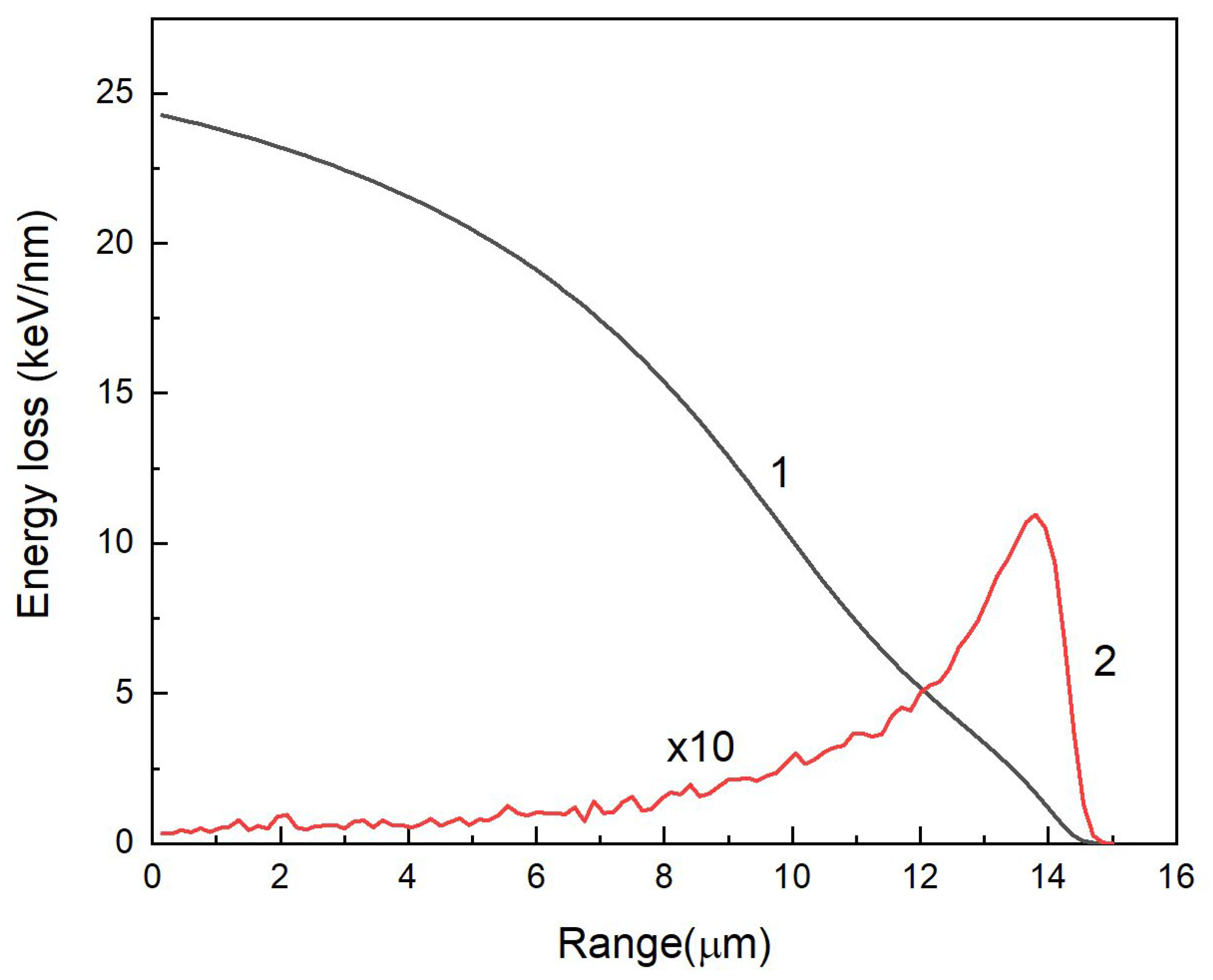
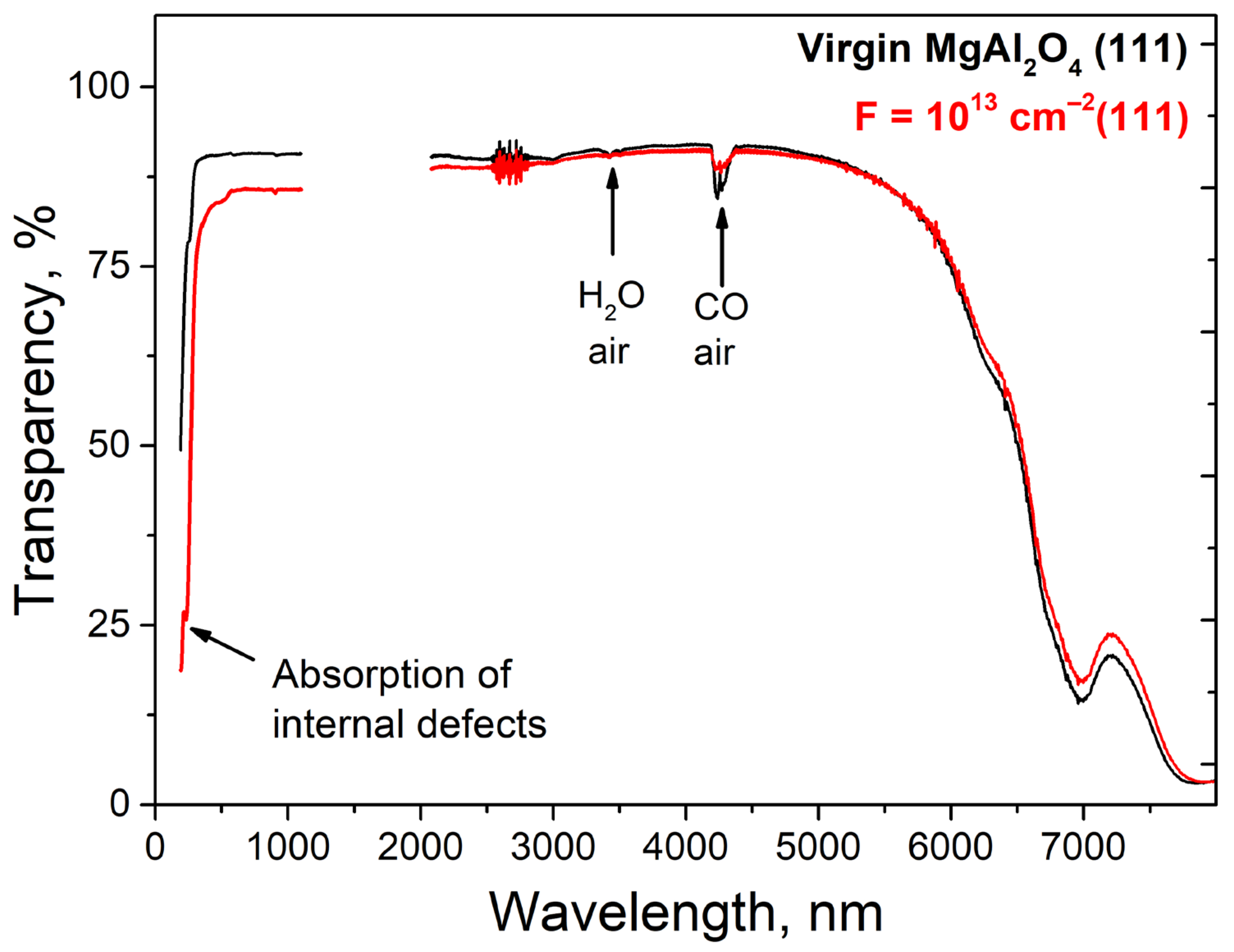
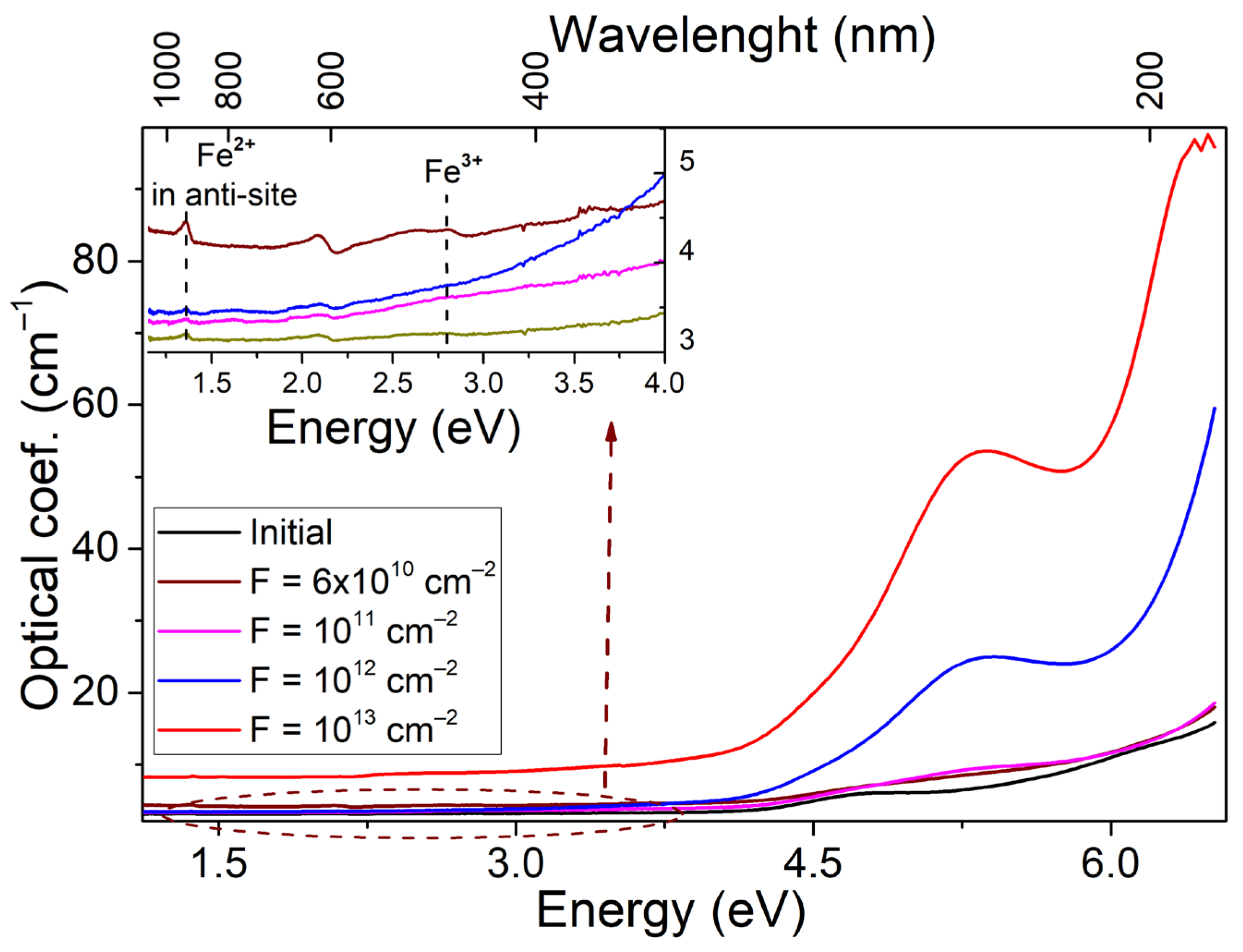
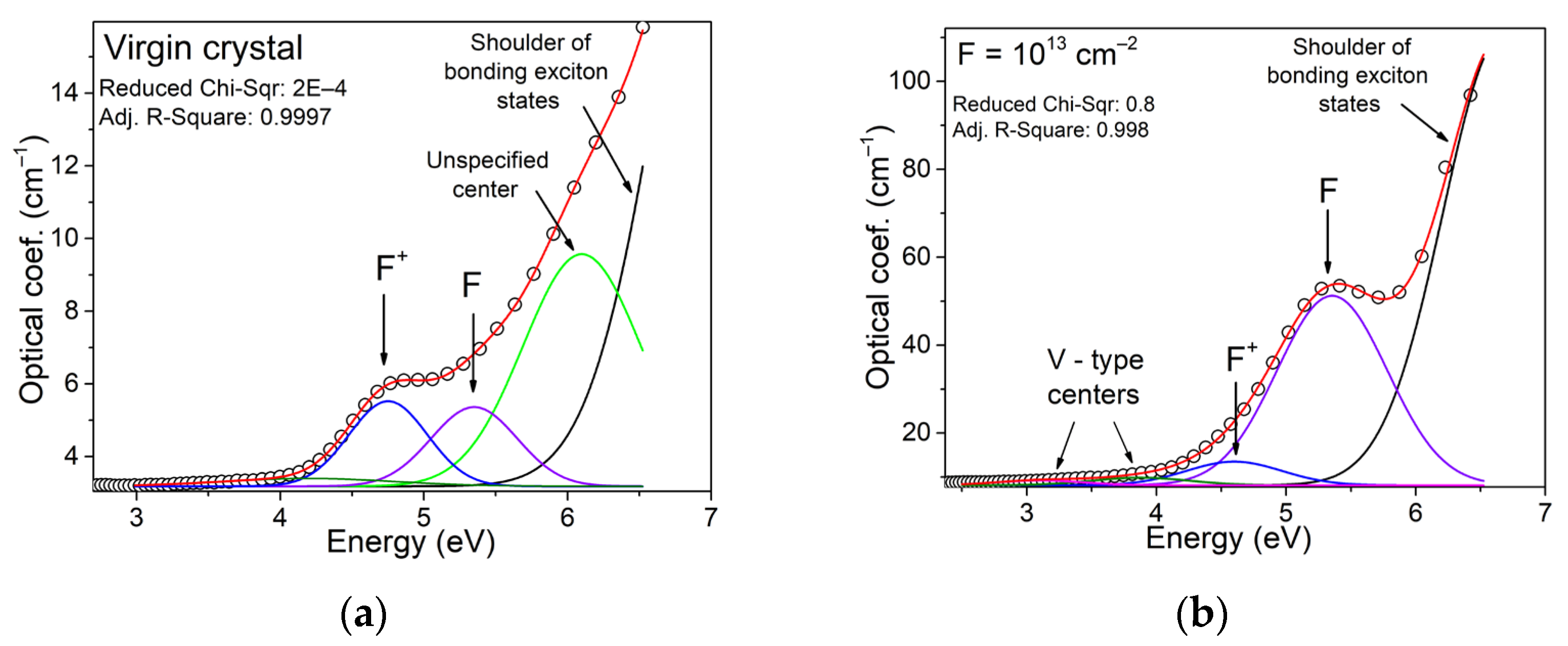
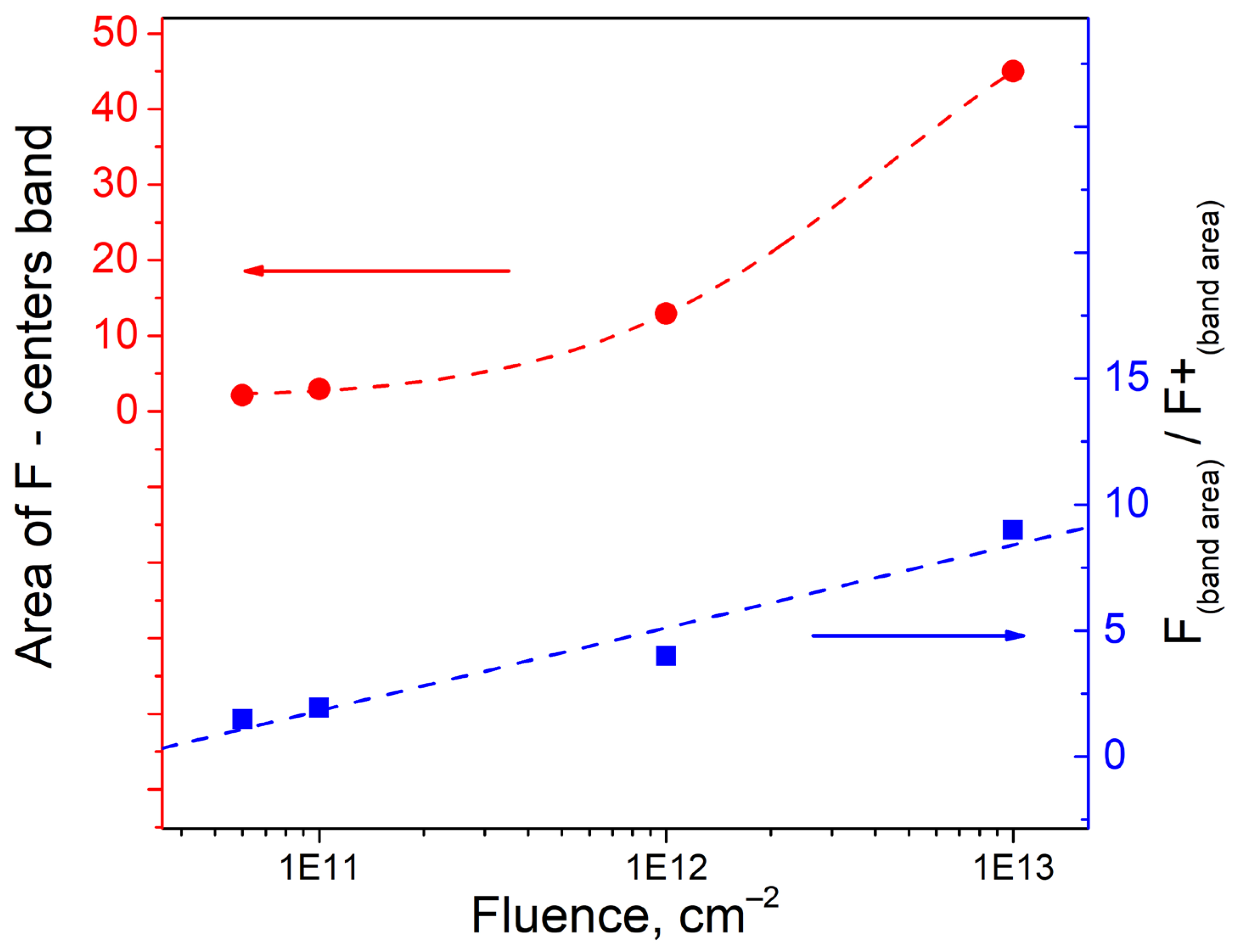

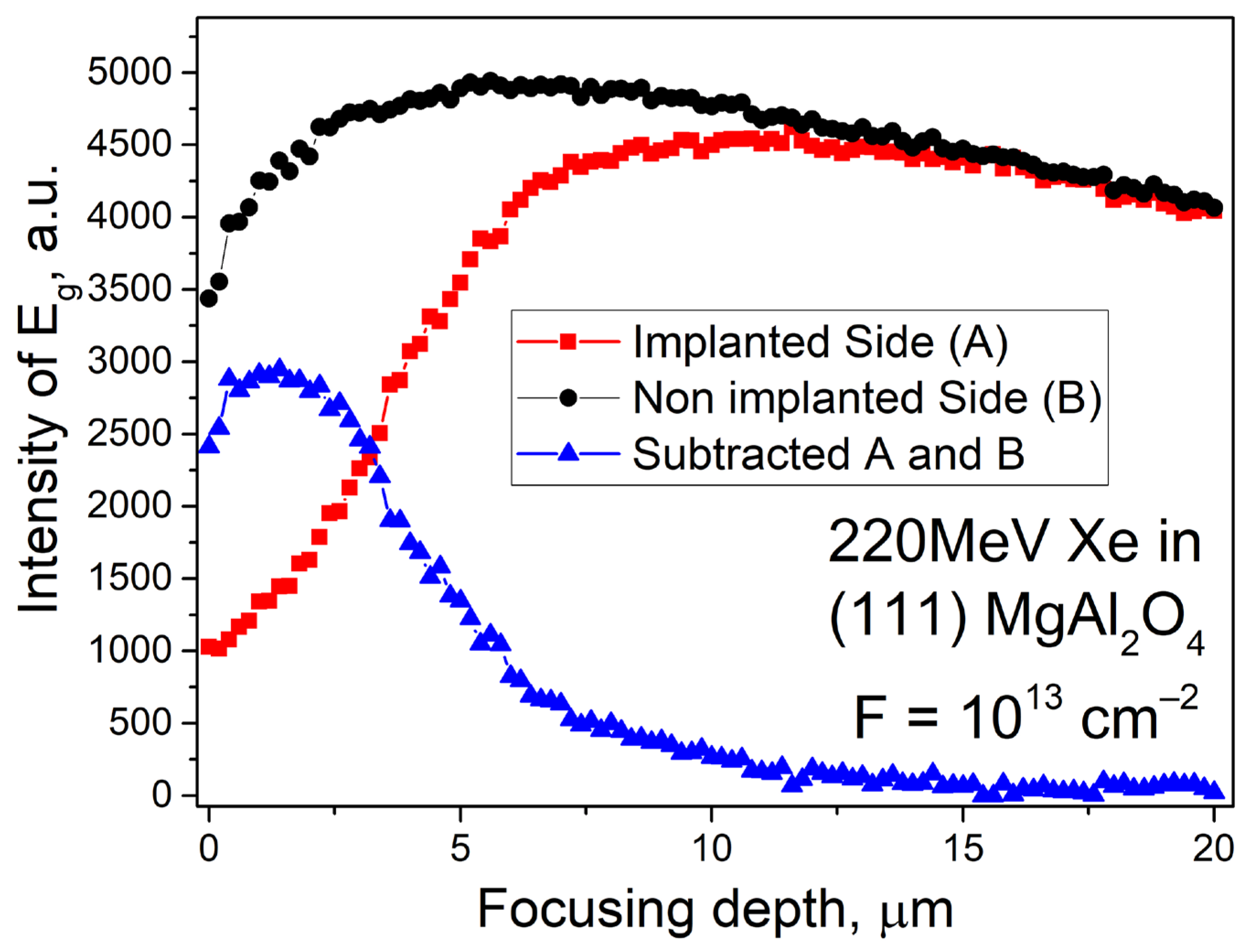
| Ion & Energy, MeV | Fluence, cm−2 | Rp, μm | <Se>, keV/nm | <Sn>, keV/nm |
|---|---|---|---|---|
| 132Xe, 220 | 1010–1014 | 14.12 | 24.3 | 0.074 |
| Defect | Model | Emax, eV | Reference |
|---|---|---|---|
| Vc − with trapped carriers | V centers | 3–4 | [26,48] |
| F+ | Vo + e | 4.75 | [53] |
| F | Vo + 2e | 5.3 | [53] |
| Fe3+ 6A1g→4Eg | Fe3+ in octahedral position | 2.7 | [54] |
| Fe2+ 5T2→5E | Fe2+ in octahedral position | 1.2 | [54] |
| Plasmon | Sample holder (Plasmon resonance on copper plate) | 2.1 | [55] |
| Fluence, cm−2 | F-Centers Area | F+ Centers Area | F/F+ |
|---|---|---|---|
| - | 1.63 | 1.6 | 1.01 |
| 6 × 1010 | 2.15 | 1.45 | 1.48 |
| 1 × 1011 | 2.94 | 1.51 | 1.95 |
| 1 × 1012 | 12.92 | 3.23 | 4 |
| 1 × 1013 | 45 | 5 | 9 |
Disclaimer/Publisher’s Note: The statements, opinions and data contained in all publications are solely those of the individual author(s) and contributor(s) and not of MDPI and/or the editor(s). MDPI and/or the editor(s) disclaim responsibility for any injury to people or property resulting from any ideas, methods, instructions or products referred to in the content. |
© 2023 by the authors. Licensee MDPI, Basel, Switzerland. This article is an open access article distributed under the terms and conditions of the Creative Commons Attribution (CC BY) license (https://creativecommons.org/licenses/by/4.0/).
Share and Cite
Akilbekov, A.; Kiryakov, A.; Baubekova, G.; Aralbayeva, G.; Dauletbekova, A.; Akylbekova, A.; Ospanova, Z.; Popov, A.I. Optical Characteristics of MgAl2O4 Single Crystals Irradiated by 220 MeV Xe Ions. Materials 2023, 16, 6414. https://doi.org/10.3390/ma16196414
Akilbekov A, Kiryakov A, Baubekova G, Aralbayeva G, Dauletbekova A, Akylbekova A, Ospanova Z, Popov AI. Optical Characteristics of MgAl2O4 Single Crystals Irradiated by 220 MeV Xe Ions. Materials. 2023; 16(19):6414. https://doi.org/10.3390/ma16196414
Chicago/Turabian StyleAkilbekov, Abdirash, Arseny Kiryakov, Guldar Baubekova, Gulnara Aralbayeva, Alma Dauletbekova, Aiman Akylbekova, Zhulduz Ospanova, and Anatoli I. Popov. 2023. "Optical Characteristics of MgAl2O4 Single Crystals Irradiated by 220 MeV Xe Ions" Materials 16, no. 19: 6414. https://doi.org/10.3390/ma16196414
APA StyleAkilbekov, A., Kiryakov, A., Baubekova, G., Aralbayeva, G., Dauletbekova, A., Akylbekova, A., Ospanova, Z., & Popov, A. I. (2023). Optical Characteristics of MgAl2O4 Single Crystals Irradiated by 220 MeV Xe Ions. Materials, 16(19), 6414. https://doi.org/10.3390/ma16196414









